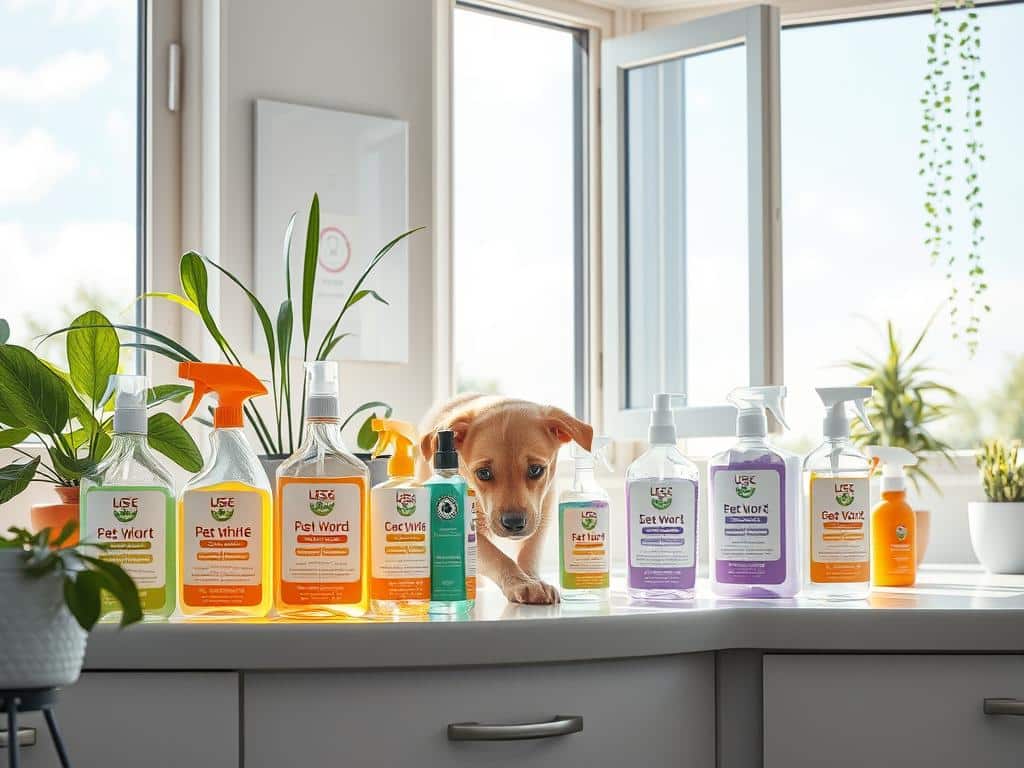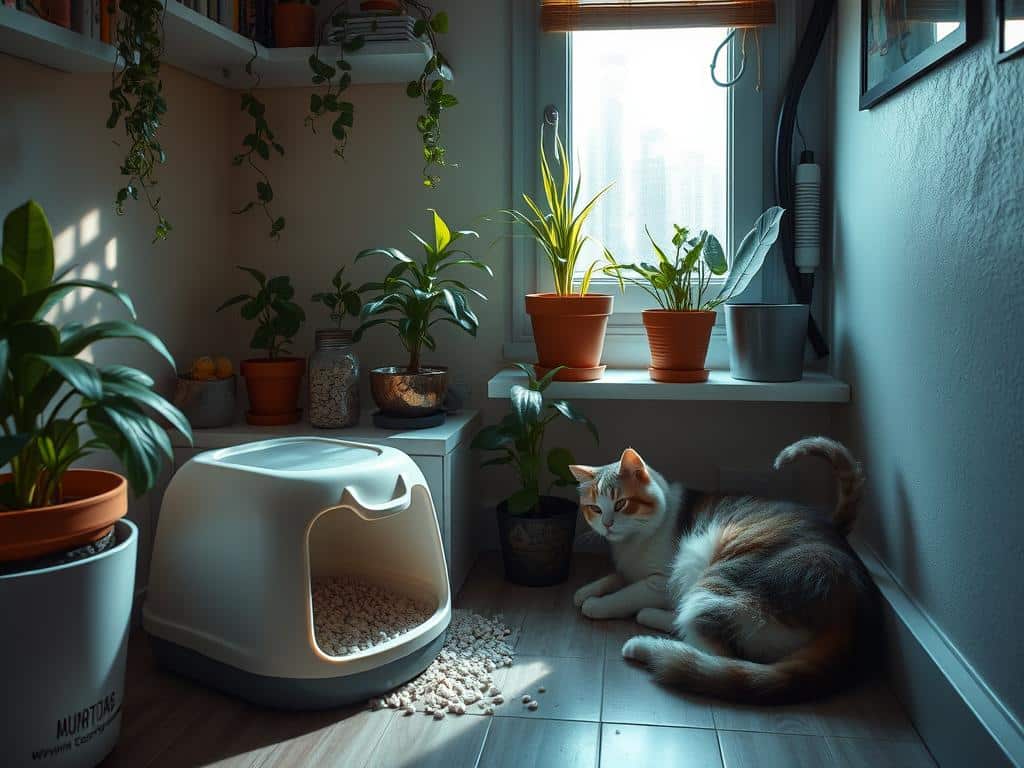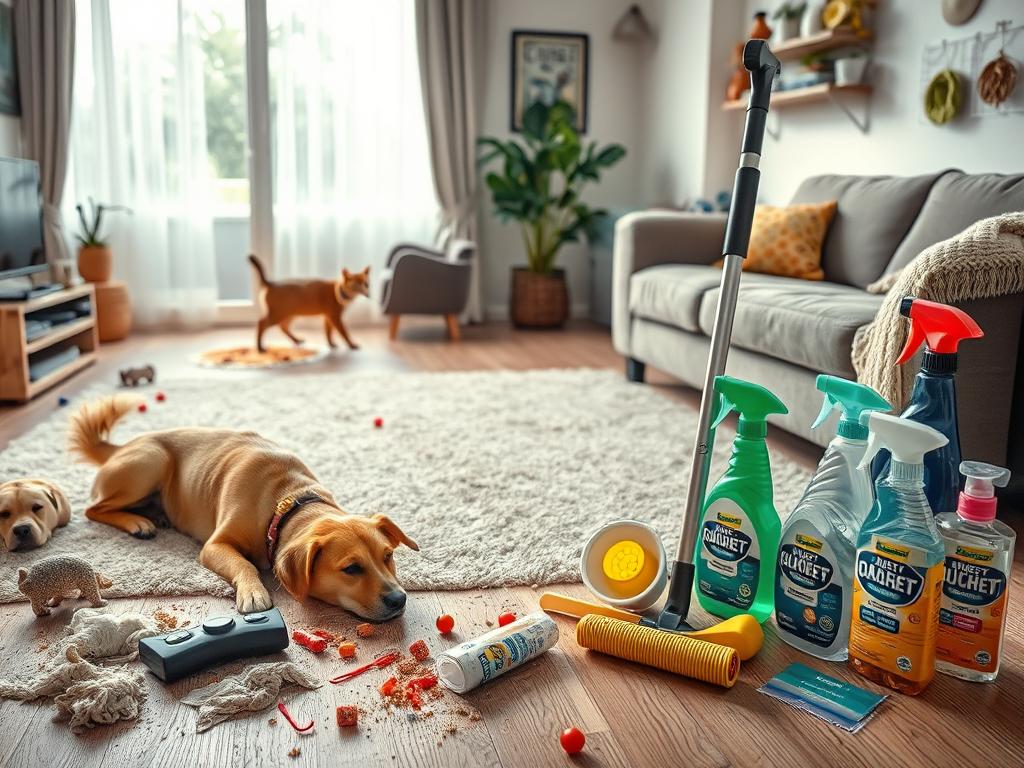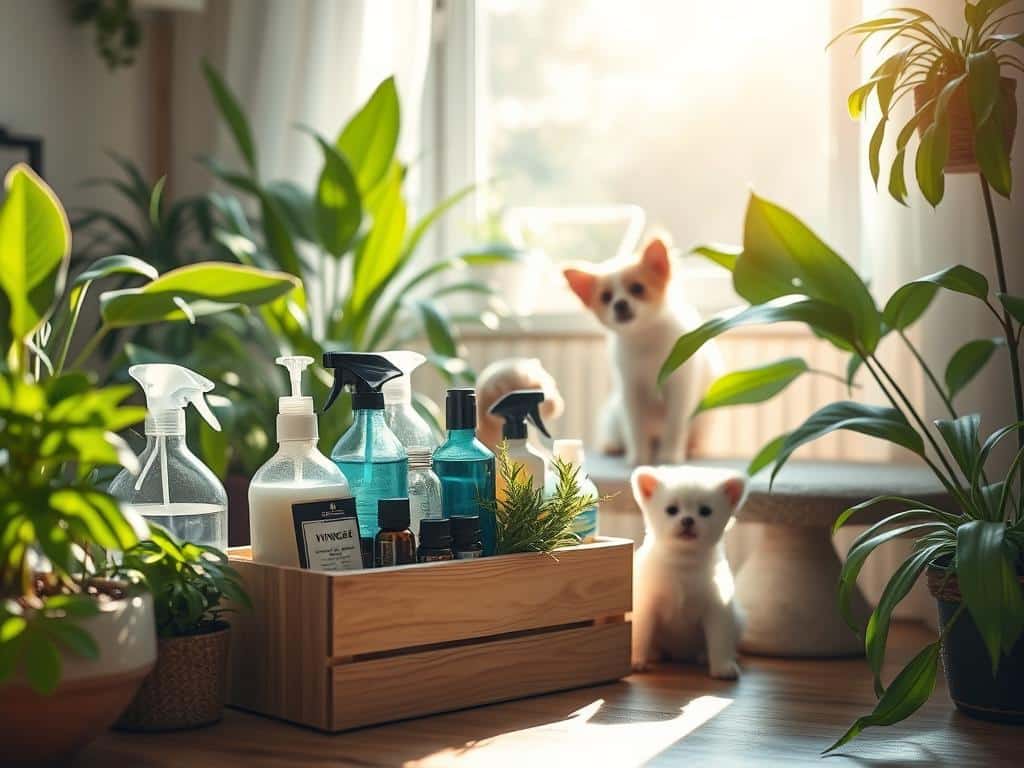
Making your home clean and safe for you and your pets is key. Many cleaning products have harsh chemicals. These can be toxic to animals due to their smaller sizes and habits like sniffing and licking. It’s important to use cleaning methods that are safe for pets, avoiding substances like bleach, ammonia, and formaldehyde.
Choose non-toxic, biodegradable cleaners and ventilate well when cleaning. Brands like ESNTL LVG have eco-friendly cleaning products made from natural ingredients. They clean as well as traditional products but are safer. K9 Resorts Luxury Pet Hotel uses hospital-grade sanitizers that are safe for pets.
To create a pet-safe home, add green cleaning solutions to your routine. This protects your pets and keeps your home clean. It’s a win-win.
Protecting your pets means choosing safe cleaning products and a pet-friendly cleaning routine. Use non-toxic cleaners, control odors wisely, and keep a steady cleaning schedule. Stay informed to make the best decisions for your pets’ well-being.
Understanding Pet-Safe Cleaning Products
Keeping your pets safe starts with using pet-friendly cleaners. These cleaners are made to be nontoxic. They help shield our furry friends from dangers found in many homes.
We will look into why these cleaners are a good choice. We will also discuss the risks of harmful chemicals. Lastly, we explain what to look for in eco-friendly products.
Non-Toxic Ingredients to Look For
Knowing which ingredients are pet-safe is key. Baking soda, vinegar, and some essential oils are usually safe. They clean well and are safer than chemical products.
Choosing options without added fragrances can protect pets from harsh smells. Biodegradable products are also a good choice for their health.
- Baking Soda
- Vinegar
- Organic Dye-Free Detergents
- Plant-Based Vegan Biodegradable Products
Common Harmful Chemicals in Traditional Products
It’s important to recognize the dangers of chemicals in cleaners. In 2021, 8.3% of pet poison calls were due to these products. Harmful substances like ammonia and bleach can cause serious health issues.
Cats are at a greater risk because of their small size. Make sure to steer clear of products with dangerous chemicals listed below:
- Alcohol
- Ammonia
- Bleach
- Chlorine
- Formaldehyde
- Hydrogen Peroxide
- Phenol
- Phthalates
Criteria for Eco-Friendly Labels
Choosing eco-friendly products shows you care about safety and the planet. Look for biodegradable ingredients and honest labeling. Credible certifications are a good sign a product is safe.
Pet-safe products will say they are made for pets. Reading labels closely helps avoid any harmful chemicals. Getting pet health insurance might also be wise. It can help cover vet bills if your pet gets sick from toxins.
Choosing non-toxic solutions and being careful with labels means a safer home. Your pets and the planet will thank you for it.
Common Household Items for Pet-Safe Cleaning
Making your home safe for pets means choosing natural cleaners. Vinegar, baking soda, lemon juice, and Castile soap can do the job well. They’re safe for pets and work great for cleaning and disinfecting. You can use them in many ways for different cleaning tasks.
Benefits of Using Vinegar
Vinegar is a fantastic natural cleaner. It can kill many types of bacteria. This is because of the acetic acid. Vinegar also gets rid of bad smells. So, it’s great for keeping your home fresh and clean.
How to Use Baking Soda
Baking soda is incredibly versatile and safe for pets. It’s good at getting rid of odors in carpets and upholstery. Mixing it with vinegar can make a strong paste for hard stains and grime. It’s gentle, so it’s safe to use around your furry friends.
Lemon Juice as a Natural Cleaner
Lemon juice is great at fighting bacteria. Its high acidity cuts through grease and makes surfaces shine. Mixed with water, it’s a safe and effective cleaner around pets. Plus, it leaves a nice, citrusy smell in the air.
Castile Soap for Various Cleaning Tasks
Castile soap comes from plant oils and is biodegradable. It’s good for many cleaning jobs in your home. Use it on pet bedding, floors, and toys. Mixed with lemon juice, it’s even more versatile. And it’s always safe around pets.
Eco-Friendly Cleaning Techniques
Keeping your home clean with pets around can be tough. But, eco-friendly cleaning methods can help. They make your home safer and cleaner for everyone. Using green cleaning tips regularly helps with allergies and removes pet dander. It also protects the environment.
Regular Vacuuming
Vacuuming often is key to lessening allergens and pet dander at home. A vacuum with a HEPA filter is best. It catches tiny particles that other vacuums might miss. This helps keep the air indoors clean and manages allergies well.
Spot Cleaning Basics
Cleaning spots right away is crucial when pets have accidents. Use enzyme-based cleaners for effective cleaning. They break down organic stuff well. This is an important part of cleaning without harsh chemicals. It keeps surfaces safe for pets and people.
Steam Cleaning for Deep Cleaning
Steam cleaning is great for a deeper clean of carpets and furniture. It doesn’t use chemicals and uses high heat to kill germs, allergens, and dust mites. It’s a top choice for those who avoid chemicals in cleaning.
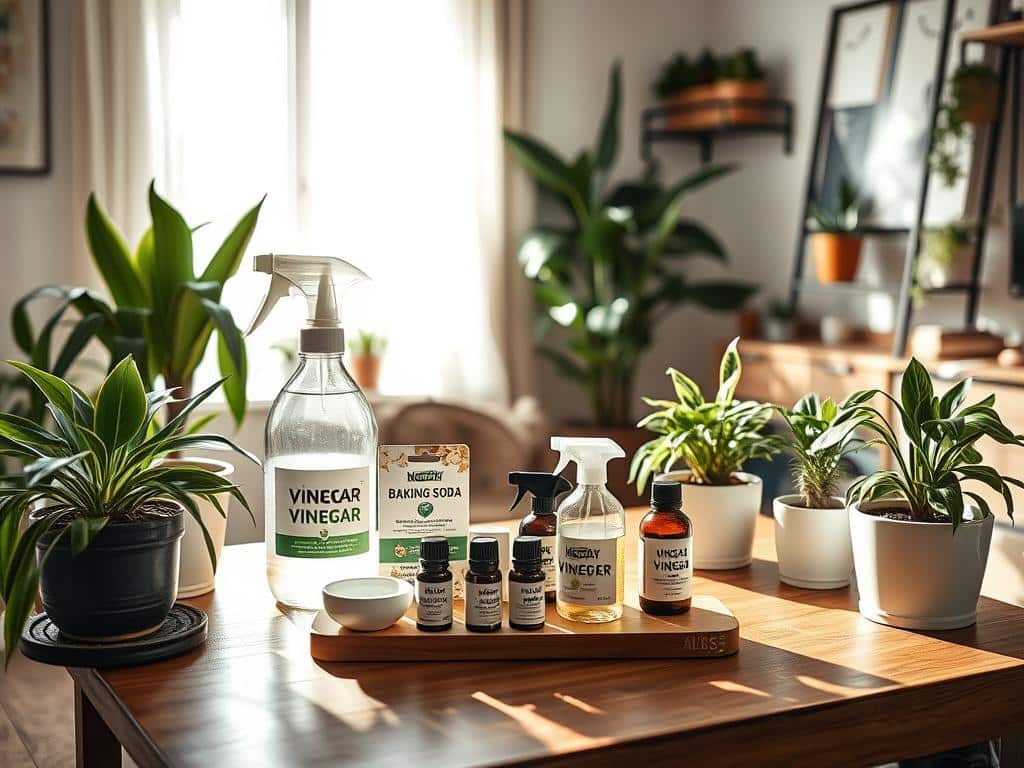
Using eco-friendly cleaning ways, you can keep a healthy home for pets and family. Choosing green cleaning tips helps make your living space safer and better for the planet.
Eco-Friendly Pet Cleaning Tips
Keeping your home clean and safe for pets means using eco-friendly methods. These practices lower risks and support the environment.
Ventilation and Storage Tips
Clearing the air of harmful fumes is critical when cleaning around pets. Open windows and run fans to bring in fresh air. Store cleaning supplies safely away from pets, preventing accidental poisoning. Discover more about protecting your home here.
Designated Pet-Free Zones During Cleaning
Keep pets away from areas being cleaned to lessen their exposure. Set up pet-free spots for them to stay during the process. This keeps them safe and lets you clean more efficiently.
Thorough Rinsing of Surfaces
It’s crucial to rinse cleaned surfaces well. This removes any leftover cleaning agents. You’ll ensure your pet’s space is both clean and safe.
- Use biodegradable waste bags to reduce environmental harm.
- Opt for sustainable cat litter made from recycled paper or plant fibers.
- Invest in durable toys to lower the frequency of replacements.
Adopting these tips leads to a cleaner, healthier home and a greener earth.
Natural Deodorizing Solutions
Keeping your home fresh and clean is vital when you have pets. Finding natural ways to remove smells is important. It keeps your pets safe and happy.
Using Baking Soda for Odor Control
Baking soda is a simple and effective way to fight odors. Spread it on carpets, furniture, and pet beds to soak up bad smells. Let it sit for 15 minutes, then vacuum. Using it regularly can make a big difference in your home.
Making Your Own Air Fresheners
Creating air fresheners yourself is good for the environment. Mix 1 cup of water and 1 cup of distilled white vinegar. Add a few drops of pet-safe essential oil and 2 tablespoons of baking soda. Lavender and eucalyptus oils can make your home smell nice and are safe for pets.
To make these fresheners:
- Mix all ingredients in a spray bottle.
- Shake the bottle well.
- Use the spray in smelly areas.
Benefits of Activated Charcoal
Activated charcoal is great for removing odors in an eco-friendly way. It’s very good at absorbing smells. Put it near places your pets spend a lot of time, like their bed or the litter box. Make sure it’s out of their reach to avoid any problems. Activated charcoal can keep your home smelling fresh.
Cleaning Pet-Specific Areas
Keeping your home clean is important, especially for pet areas. It’s key to clean pet beds, blankets, toys, and litter boxes often. This makes pets comfy and keeps your house clean. Use safe, eco-friendly products from Mrs. Meyer’s, Seventh Generation, Method, and Nature’s Miracle. Now, let’s learn how to clean different pet areas well, to have a fresh, pet-friendly home.
Pet Beds and Blankets
Cleaning pet beds and blankets is a must. It gets rid of fur, dander, and smells. Use unscented, safe detergents for weekly washes. Mrs. Meyer’s has good eco-friendly options for this. Washing with hot water can kill bacteria and allergens. This helps keep your home healthy.
Safe Cleaning of Pet Toys
Pet toys need regular cleaning since pets put them in their mouths. Clean hard toys with vinegar or in the dishwasher on a gentle cycle. Wash soft toys with eco-friendly detergent. Always check toys for damage and throw away broken ones to keep pets safe.
Managing Litter Box Odor
For cat owners, litter box care is important every day to stop bad smells. Scoop it daily and change the litter every week. Clean the box with hot water and safe soap, like Ecochem’s Eco-Greener cleaner. Put baking soda at the bottom for extra freshness. This method is safe for pets and keeps the area nice smelling.
By cleaning these pet areas with safe products, you make a healthy home for you and your pets. Regular cleaning keeps your home nice and pets happy.

